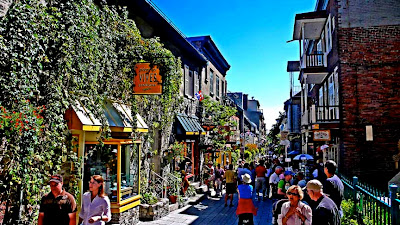Ville de Québec
 Vue sur Québec — Port of Québec on the
Vue sur Québec — Port of Québec on the Saint Lawrence River taken from
De l’Observatire de la Capitale viewing tower
725 feet above sea level.
Our campground, Camping Juneau on Lake Augustine, was conveniently located just off of autoroute 40. Our camp hostess instructed us, “Don’t turn off anywhere, just go straight forward into ville de Québec." (only 18 km, about 12 miles, along freeway 40, straight ahead on 440, then Boulevard Charest Est, then St. Paul which curves around the base of Old Québec to the Old Port and commercial parking area on the shore of the St. Lawrence River.)
We did take her advice to return to camp at the end of the day, but made use of our GPS, Nellie, to first take us up on the bluff to the Vue sur Québec, from the Observatory of the Capital of Québec Province. Finding road construction blocking several streets and full parking lots, we drove into Des Plaines d’Abraham a large civic park, resembling Golden Gate Park in San Francisco where we found free curb-side parking several blocks away. We cut across a grassy slope, Bill going to the left to the Viewing Tower and Jean to the right to the Tourist Information Center.
After enjoying our lunch in the park, Bill slowly went with the traffic through the narrow streets of Old Town, down the steep Cote de la Montagne to the Old Port below. One thing that we learned quickly: Jean’s knowledge of French was going to be needed. The Québequois, at least the government, is as paranoid about the French language as the country of France is. One striking example: all over the rest of Canada and in most of the northern states every sign and all product labels are written in English AND French, but not in Québec—here only French is found, no English.
At Place Royal, the first French settlement in North America, founded by Samuel de Champlain in 1608, we visited the little stone church, Notre-Dame des-Victoires, “Our Lady of Victories,” built in 1688 on the foundation of Samuel de Champlain’s trading post. The famous Chateau Frontenac towers overhead. We sauntered along cobblestone streets among the tourists; Jean bought postcards and Bill indulged in an ice cream cone ($3.50). Nearby is the base of the funicular that you can take to the upper town rather than climb the steep stairway.
Taking the straight road home around 4 p.m. seemed interminably slow through the narrow streets of the town with bumper to bumper one-lane traffic, very rough pavement and many signals, until it became a freeway for the last few miles to our campground.
Ste. Anne de Beaupré
The next day we headed northeast, about 20 miles beyond the town of Québec to the shrine of Ste. Anne de Beaupré, using the slightly longer freeway 40 detour around the town of Québec and arriving just in time for the 11:30 a.m. pilgrim’s Mass. The beautiful basilica is a peaceful, quiet place out in the country. During the 350 years of it’s existence, many healings have taken place here, credited to Saint Anne, the mother of the Virgin Mary. In 1876, at the opening of the first basilica, Saint Anne was proclaimed patroness of the Province of Québec.
 The doors are sheathed in beautiful polished copper.
The doors are sheathed in beautiful polished copper. This panel depicts
The Annunciation to the Blessed Virgin Mary.
 We were inspired
We were inspiredby a special service for pilgrims.
Strolling about the grounds after Mass, we noticed a small building with the title, "Counseling and Blessings." Curious, we went in and met a very black, young priest from Burkina Fasso, Africa. We shared mission-talk briefly, until another pilgrim arrived. We left feeling very much at peace after receiving his priestly blessing.












